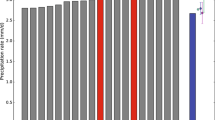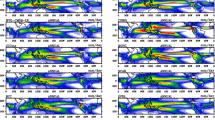Abstract
The Global/Regional Integrated Model system (GRIMs) is upgraded to version 4.0, with the advancement of the moisture advection scheme and physics package, focusing on the global model program (GMP) for seasonal simulation and climate studies. Compared to the original version 3.1, which was frozen in 2013, the new version shows no Gibbs phenomenon in the moisture and tracer fields by implementing the semi-Lagrangian advection scheme with a better computational efficiency at higher resolution. The performance of the seasonal ensemble simulation (June–August 2017 and December 2016–February 2017) is significantly improved by new physics and ancillary data. The advancement is largest in the stratosphere, where the cold bias is dramatically reduced and the wind bias of the polar jets is alleviated, especially for the winter hemisphere. Noticeable improvements are also found in tropospheric zonal mean circulation, eddy transport, precipitation, and surface air temperature. This allows GRIMs version 4.0 to be used not only for long-term climate simulations, but also for subseasonal-to-seasonal climate prediction.











Similar content being viewed by others
References
Adler, R.F., et al.: The Global Precipitation Climatology Project (GPCP) monthly analysis (New Version 2.3) and a review of 2017 global precipitation. Atmosphere 9, 138 (2018)
Bae, S.Y., Park, R.S.: Consistency between the cloud and radiation processes in a numerical forecasting model. Meteorol. Atmos. Phys. 131, 1429–1436 (2019)
Barlage, M., Zeng, X., Wei, H., Mitchell, K.E.: A global 0.05° maximum albedo dataset of snow-covered land based on MODIS observations. Geophys. Res. Lett. 32, L17405 (2005)
Blossey, P.N., Durran, D.R.: Selective monotonicity preservation in scalar advection. J. Comput. Phys. 227, 5160–5183 (2008)
Briegleb, B.P., Minnis, P., Ramanathan, V., Harrison, E.: Comparison of regional clear-sky albedos inferred from satellite observations and model computations. J. Climate Appl. Meteorol. 25, 214–226 (1986)
Butchart, N., et al.: Overview of experiment design and comparison of models participating in phase 1 of the SPARC Quasi-Biennial Oscillation initiative (QBOi). Geosci. Model. Dev. 11, 1009–1032 (2018)
Byun, Y.-H., Hong, S.-Y.: Improvements in the Subgrid-scale representation of moist convection in a cumulus parameterization scheme: the single-column test and its impact on seasonal prediction. Mon. Wea. Rev. 135, 2135–2154 (2007)
Chang, E.C., Yoshimura, K.: A semi-Lagrangian advection scheme for radioactive tracers in the NCEP Regional Spectral Model (RSM). Geosci. Model. Dev. 8, 3247–3255 (2015)
Charnock, H.: Wind stress on a water surface. Q. J. R. Meteorol. Soc. 81, 639–640 (1955)
Choi, H.-J., Hong, S.-Y.: An updated subgrid orographic parameterization for global atmospheric forecast models. J. Geophys. Research: Atmos. 120, 12445–12457 (2015)
Chou, M.-D., Suarez, M.J.: A solar radiation parameterization for atmospheric studies. NASA/TM-1999-104606, 38 pp (1999)
Chou, M.-D., Lee, K.-T.: A parameterization of the effective layer emission for infrared radiation calculations. J. Atmos. Sci. 62, 531–541 (2005)
Chou, M.-D., Lee, K.-T., Tsay, S.-C., Fu, Q.: Parameterization for cloud longwave scattering for use in atmospheric models. J. Clim. 12, 159–169 (1999)
Chun, H.-Y., Baik, J.-J.: Momentum flux by thermally induced internal gravity waves and its approximation for large-scale models. J. Atmos. Sci. 55, 3299–3310 (1998)
Colella, P., Woodward, P.R.: The Piecewise Parabolic Method (PPM) for gas-dynamical simulations. J. Comput. Phys. 54, 174–201 (1984)
Colella, P., Sekora, M.D.: A limiter for PPM that preserves accuracy at smooth extrema. J. Comput. Phys. 227, 7069–7076 (2008)
Edmon, H.J., Hoskins, B.J., McIntyre, M.E.: Eliassen-palm cross sections for the troposphere. J. Atmos. Sci. 37, 2600–2616 (1980)
Ek, M.B., Mitchell, K.E., Lin, Y., Rogers, E., Grunmann, P., Koren, V., Gayno, G., Tarpley, J.D.: Implementation of Noah land surface model advances in the National Centers for Environmental Prediction operational mesoscale Eta model. J. Phys. Res. 108, 8851 (2003)
Gutman, G., Ignatov, A.: The derivation of the green vegetation fraction from NOAA/AVHRR data for use in numerical weather prediction models. Int. J. Remote Sens. 19, 1533–1543 (1998)
Han, J.-Y., Hong, S.-Y., Kwon, Y.C.: The performance of a revised Simplified Arakawa–Schubert (SAS) convection scheme in the medium-range forecasts of the Korean Integrated Model (KIM). Weather Forecast. 35, 1113–1128 (2020)
Han, J.-Y., Hong, S.-Y., Lim, K.-S.S., Han, J.: Sensitivity of a cumulus parameterization scheme to precipitation production representation and its impact on a heavy rain event over Korea. Mon. Weather Rev. 144, 2125–2135 (2016)
Hong, S.-Y.: A new stable boundary-layer mixing scheme and its impact on the simulated East Asian summer monsoon. Q. J. R. Meteorol. Soc. 136, 1481–1496 (2010)
Hong, S.-Y., Jang, J.: Impacts of shallow convection processes on a simulated boreal summer climatology in a global atmospheric model. Asia-Pacific J. Atmos. Sci. 54, 361–370 (2018)
Hong, S.-Y., Juang, H.-M.H., Zhao, Q.: Implementation of prognostic cloud scheme for a regional spectral model. Mon. Weather Rev. 126, 2621–2639 (1998)
Hong, S.-Y., Dudhia, J., Chen, S.-H.: A revised approach to ice microphysical processes for the bulk parameterization of clouds and precipitation. Mon. Weather Rev. 132, 103–120 (2004)
Hong, S.-Y., Noh, Y., Dudhia, J.: A new vertical diffusion package with an explicit treatment of entrainment processes. Mon. Weather Rev. 134, 2318–2341 (2006)
Hong, S.-Y., Choi, J., Chang, E.-C., Park, H., Kim, Y.-J.: Lower-tropospheric enhancement of gravity wave drag in a global spectral atmospheric forecast model. Weather Forecast. 23, 523–531 (2008)
Hong, S.-Y., et al.: The Korean Integrated Model (KIM) system for global weather forecasting. Asia-Pacific J. Atmos. Sci. 54, 267–292 (2018)
Hong, S.-Y., et al.: The Global/Regional Integrated Model system (GRIMs). Asia-Pacific J. Atmos. Sci. 49, 219–243 (2013)
Iacono, M.J., Delamere, J.S., Mlawer, E.J., Shephard, M.W., Clough, S.A., Collins, W.D.: Radiative forcing by long-lived greenhouse gases: Calculations with the AER radiative transfer models. J. Geophys. Res.: Atmos. 113, D13103 (2008)
Jeon, J.-H., Hong, S.-Y., Chun, H.-Y., Song, I.-S.: Test of a convectively forced gravity wave drag parameterization in a general circulation model. Asia-Pacific J. Atmos. Sci. 46, 1–10 (2010)
Jeong, Y.-C., Yeh, S.-W., Lee, S., Park, R.J.: A global/regional integrated model system-chemistry climate model: 1. Simulation characteristics. Earth Space Sci. 6, 2016–2030 (2019)
Juang, H.-M.H.: Semi-Lagrangian advection without iteration. In: Proceedings of the Conference on Weather Analysis and Forecasting, Longtan, Taoyan, Taiwan, Central Weather Bureau, 227 (2007)
Juang, H.-M.H., Hong, S.-Y.: Forward semi-lagrangian advection with mass conservation and positive definiteness for falling hydrometeors. Mon. Weather Rev. 138, 1778–1791 (2010)
Kent, J., Ullrich, P.A., Jablonowski, C.: Dynamical core model intercomparison project: Tracer transport test cases. Q. J. R. Meteorol. Soc. 140, 1279–1293 (2014)
Kim, E.-J., Hong, S.-Y.: Impact of air-sea interaction on East Asian summer monsoon climate in WRF. J. Phys. Res. 115, D19118 (2010)
Kim, Y.-J., Arakawa, A.: Improvement of orographic gravity wave parameterization using a mesoscale gravity wave model. J. Atmos. Sci. 52, 1875–1902 (1995)
Koo, M.-S., Hong, S.-Y.: Double fourier series dynamical core with hybrid sigma-pressure vertical coordinate. Tellus A: Dyn. 65, 19851 (2013)
Koo, M.-S., Choi, H.-J., Han, J.-Y.: A parameterization of turbulent-scale and mesoscale orographic drag in a global atmospheric model. J. Geophys. Res.: Atmos. 123, 8400–8417 (2018)
Lauritzen, P.H., Jablonowski, C., Taylor, M.A., Nair, R.D.: Rotated versions of the jablonowski steady-state and baroclinic wave test cases: a dynamical core intercomparison. J. Adv. Model. Earth Syst. 2, 15 (2010)
Lee, S., Park, R.J., Hong, S.Y., et al.: A New Chemistry-climate model GRIMs-CCM: model evaluation of interactive chemistry-meteorology simulations. Asia-Pac J. Atmos. Sci. (2022). https://doi.org/10.1007/s13143-022-00281-6
Long, P.J.: An general unified similarity theory for the calculation of turbulent fluxes in the numerical weather prediction models for unstable condition. Office Note 302, p. 330. U.S. Department of Commerce, National oceanic and Atmospheric Administration, National Weather Service, National Meteorological Center (1984)
Long, P.J.: An economical and compatible scheme for parameterizing the stabl surface layer in the medium-range forecast model, Office Note 321, p. 324. U.S. Department of Commerce, National oceanic and Atmospheric Administration, National Weather Service, National Meteorological Center (1986)
Lu, B., Zhong, J., Wang, W., Tang, S., Zheng, Z.: Influence of near real-time green vegetation fraction data on numerical weather prediction by WRF over North China. J. Meteorol. Res. 35, 505–520 (2021)
Mitchell, K., et al.: The community noah Land-Surface Model (LSM): User’s Guide Public Release Version 2.7.1. NCEP (2005)
Mocko, D.M., Cotton, W.R.: Evaluation of fractional cloudiness parameterizations for use in a mesoscale model. J. Atmos. Sci. 52, 2884–2901 (1995)
Orszag, S.A.: Transform method for the calculation of vector-coupled sums: application to the spectral form of the vorticity equation. J. Atmos. Sci. 27, 890–895 (1970)
Park, H., Hong, S.-Y.: An Evaluation of a mass-flux cumulus parameterization scheme in the KMA global forecast system. J. Meteor. Soc. Jpn. 85, 151–169 (2007)
Park, R.-S., Chae, J.-H., Hong, S.-Y.: A revised prognostic cloud fraction scheme in a global forecasting system. Mon. Weather Rev. 144, 1219–1229 (2016)
Schär, C., Leuenberger, D., Fuhrer, O., Lüthi, D., Girard, C.: A new terrain-following vertical coordinate formulation for atmospheric prediction models. Mon. Weather Rev. 130, 2459–2480 (2002)
Staniforth, A., Côté, J.: Semi-lagrangian integration schemes for atmospheric models—A review. Mon. Weather Rev. 119, 2206–2223 (1991)
Sundqvist, H., Berge, E., Kristjánsson, J.E.: Condensation and cloud parameterization studies with a mesoscale numerical weather prediction model. Mon. Weather Rev. 117, 1641–1657 (1989)
Taylor, J.P., Edwards, J.M., Glew, M.D., Hignett, P., Slingo, A.: Studies with a flexible new radiation code. II: Comparisons with aircraft short-wave observations. Q. J. R. Meteorol. Soc. 122, 839–861 (1996)
Ullrich, P.A., Jablonowski, C., Kent, J., Lauritzen, P.H., Nair, R.D., Taylor, M.A.: Dynamical Core Model Intercomparison Project (DCMIP) test case document. NCAR Tech. Doc., pp 83 (2012). Available online at http://websites.umich.edu/~cjablono/DCMIP-2012_TestCaseDocument_v1.7.pdf
Williamson, D.L.: Semi-Lagrangian moisture transport in the NMC spectral model. Tellus A 42, 413–428 (1990)
Williamson, D.L.: The evolution of dynamical cores for global atmospheric models. J. Meteor. Soc. Jpn. 85B, 241–269 (2007)
Xu, K.-M., Randall, D.A.: A semiempirical cloudiness parameterization for use in climate models. J. Atmos. Sci. 53, 3084–3102 (1996)
Zeng, X., Wang, Z., Wang, A.: Surface skin temperature and the interplay between sensible and ground heat fluxes over arid regions. J. Hydrometeor 13, 1359–1370 (2012)
Zerroukat, M., Staniforth, A., Wood, N.: The monotonic Quartic Spline Method (QSM) for conservative transport problems. J. Comput. Phys. 229, 1150–1166 (2010)
Zhang, Y., Juang, H.-M.H.: A mass-conserving non-iteration-dimensional-split semi-Lagrangian advection scheme for limited-area modelling. Q. J. R. Meteorol. Soc. 138, 2118–2125 (2012)
Acknowledgements
This work was supported by Korea Environment Industry & Technology Institute (KEITI) through “Climate Change R&D Project for New Climate Regime”, funded by Korea Ministry of Environment (MOE) (2022003560004). Dr. Ji-Young Han and Ji-Young Oh implemented the KSAS scheme and provided CAMS-based climatological ozone data, respectively.
Author information
Authors and Affiliations
Corresponding author
Ethics declarations
Competing Interest
The authors declare no competing financial interests or personal relationship that influence the work reported in this paper.
Additional information
Responsible Editor: Daehyun Kim.
Publisher’s Note
Springer Nature remains neutral with regard to jurisdictional claims in published maps and institutional affiliations.
Supplementary Information
Below is the link to the electronic supplementary material.
ESM 1
(DOCX 2.63 MB)
Rights and permissions
Springer Nature or its licensor holds exclusive rights to this article under a publishing agreement with the author(s) or other rightsholder(s); author self-archiving of the accepted manuscript version of this article is solely governed by the terms of such publishing agreement and applicable law.
About this article
Cite this article
Koo, MS., Song, K., Kim, JE.E. et al. The Global/Regional Integrated Model System (GRIMs): an Update and Seasonal Evaluation. Asia-Pac J Atmos Sci 59, 113–132 (2023). https://doi.org/10.1007/s13143-022-00297-y
Received:
Revised:
Accepted:
Published:
Issue Date:
DOI: https://doi.org/10.1007/s13143-022-00297-y




